Formulation Attributes Impact Immune Profile of an Oral and Thermostable COVID-19 Subunit Vaccine
Abstract
1. Introduction
2. Materials and Methods
2.1. Recombinant Receptor Binding Domain (RBD) Production
2.2. Stabilizer Screening by Aggregation Inhibition
2.3. pH Profile and Buffer Screening by Dynamic Light Scattering
2.4. Vaccine Formulation
2.5. Dry Powder Vaccine Preparation
2.6. Vaccine Analysis
2.6.1. Adsorption
2.6.2. Particle Sizing by Laser Diffraction
2.6.3. Zeta Potential
2.6.4. Sodium Dodecyl Sulfate Polyacrylamide Gel Electrophoresis (SDS-PAGE)
2.6.5. ELISA
2.6.6. Mice Studies
2.6.7. Intestinal Lavage Fluid (ILF) Collection
2.6.8. Antibody Analysis
3. Results
3.1. RBD Bulk Drug Substance Stabilization
3.1.1. Stabilizer Screening
3.1.2. pH Profile and Buffer Screening
3.1.3. Confirmation of Identity and Antigenicity
3.2. Oral Vaccine Formulation Development
3.2.1. Adsorption to Aluminum Adjuvant
3.2.2. Coating Polymer Formulation
3.2.3. Final Drug Product Characterization
3.3. Mannan Dose Response Immunogenicity in Mice
3.4. Dry Powder Manufacturing
3.5. Immune Response Profiles of Liquid vs. Dry Powder Vaccines in Mice
3.6. Thermostability
3.6.1. Real Time In Vitro Stability
3.6.2. Accelerated Stability: In Vitro Study
3.6.3. Accelerated Stability: In Vivo Study
4. Discussion
5. Conclusions
Author Contributions
Funding
Institutional Review Board Statement
Informed Consent Statement
Data Availability Statement
Conflicts of Interest
References
- WHO. COVID Tracker. 2020. Available online: https://covid19.who.int/ (accessed on 10 July 2024).
- Neutra, M.R.; Kozlowski, P.A. Mucosal vaccines: The promise and the challenge. Nat. Rev. Immunol. 2006, 6, 148–158. [Google Scholar] [CrossRef] [PubMed]
- Lavelle, E.C.; Ward, R.W. Mucosal vaccines—Fortifying the frontiers. Nat. Rev. Immunol. 2022, 22, 236–250. [Google Scholar] [CrossRef] [PubMed]
- Mutsch, M.; Zhou, W.; Rhodes, P.; Bopp, M.; Chen, R.T.; Linder, T.; Spyr, C.; Steffen, R. Use of the Inactivated Intranasal Influenza Vaccine and the Risk of Bell’s Palsy in Switzerland. N. Engl. J. Med. 2004, 350, 896–903. [Google Scholar] [CrossRef] [PubMed]
- Helander, H.F.; Fändriks, L. Surface area of the digestive tract—Revisited. Scand. J. Gastroenterol. 2014, 49, 681–689. [Google Scholar] [CrossRef]
- Chen, K.; Cerutti, A. Vaccination Strategies to Promote Mucosal Antibody Responses. Immunity 2010, 33, 479–491. [Google Scholar] [CrossRef] [PubMed]
- Hase, K.; Kawano, K.; Nochi, T.; Pontes, G.S.; Fukuda, S.; Ebisawa, M.; Kadokura, K.; Tobe, T.; Fujimura, Y.; Kawano, S.; et al. Uptake through glycoprotein 2 of FimH+ bacteria by M cells initiates mucosal immune response. Nature 2009, 462, 226–230. [Google Scholar] [CrossRef] [PubMed]
- Geijtenbeek, T.B.H.; Gringhuis, S.I. Signalling through C-type lectin receptors: Shaping immune responses. Nat. Rev. Immunol. 2009, 9, 465–479. [Google Scholar] [CrossRef]
- Ermak, T.H.; Giannasca, P.J. Microparticle targeting to M cells. Adv. Drug Deliv. Rev. 1998, 34, 261–283. [Google Scholar] [CrossRef]
- Morefield, G.L.; Sokolovska, A.; Jiang, D.; HogenEsch, H.; Robinson, J.P.; Hem, S.L. Role of aluminum-containing adjuvants in antigen internalization by dendritic cells in vitro. Vaccine 2005, 23, 1588–1595. [Google Scholar] [CrossRef]
- Du, L.; Zhao, G.; Chan, C.C.S.; Sun, S.; Chen, M.; Liu, Z.; Guo, H.; He, Y.; Zhou, Y.; Zheng, B.-J.; et al. Recombinant receptor-binding domain of SARS-CoV spike protein expressed in mammalian, insect and E. coli cells elicits potent neutralizing antibody and protective immunity. Virology 2009, 393, 144–150. [Google Scholar] [CrossRef] [PubMed] [PubMed Central]
- Sheng, K.; Pouniotis, D.S.; Wright, M.D.; Tang, C.K.; Lazoura, E.; Pietersz, G.A.; Apostolopoulos, V. Mannan derivatives induce phenotypic and functional maturation of mouse dendritic cells. Immunology 2006, 118, 372–383. [Google Scholar] [CrossRef]
- Eldridge, J.H.; Meulbroek, J.A.; Staas, J.K.; Tice, T.R.; Gilley, R.M. Vaccine-containing biodegradable microspheres specifically enter the gut-associated lymphoid tissue following oral administration and induce a disseminated mucosal immune response. Adv. Exp. Med. Biol. 1989, 251, 191–202. [Google Scholar] [CrossRef] [PubMed]
- Eldridge, J.H.; Gilley, R.; Staas, J.K.; Moldoveanu, Z.; Meulbroek, J.A.; Tice, T.R. Biodegradable microspheres: Vaccine delivery system for oral immunization. Curr. Top. Microbiol. Immunol. 1989, 146, 59–66. [Google Scholar] [CrossRef] [PubMed]
- Knisely, J.M.; Buyon, L.E.; Mandt, R.; Farkas, R.; Balasingam, S.; Bok, K.; Buchholz, U.J.; D’souza, M.P.; Gordon, J.L.; King, D.F.L.; et al. Mucosal vaccines for SARS-CoV-2: Scientific gaps and opportunities—Workshop report. Vaccines 2023, 8, 53. [Google Scholar] [CrossRef]
- Baker, J.R.; Farazuddin, M.; Wong, P.T.; O’konek, J.J. The unfulfilled potential of mucosal immunization. J. Allergy Clin. Immunol. 2022, 150, 1–11. [Google Scholar] [CrossRef]
- Negi, N.; Maurya, S.P.; Singh, R.; Das, B.K. An update on host immunity correlates and prospects of re-infection in COVID-19. Int. Rev. Immunol. 2021, 41, 367–392. [Google Scholar] [CrossRef] [PubMed]
- Gallo, O.; Locatello, L.G.; Mazzoni, A.; Novelli, L.; Annunziato, F. The central role of the nasal microenvironment in the transmission, modulation, and clinical progression of SARS-CoV-2 infection. Mucosal Immunol. 2021, 14, 305–316. [Google Scholar] [CrossRef] [PubMed]
- Wang, Z.; Lorenzi, J.C.C.; Muecksch, F.; Finkin, S.; Viant, C.; Gaebler, C.; Cipolla, M.; Hoffmann, H.-H.; Oliveira, T.Y.; Oren, D.A.; et al. Enhanced SARS-CoV-2 neutralization by dimeric IgA. Sci. Transl. Med. 2021, 13, abf1555. [Google Scholar] [CrossRef] [PubMed]
- Rojas, O.L.; Pröbstel, A.-K.; Porfilio, E.A.; Wang, A.A.; Charabati, M.; Sun, T.; Lee, D.S.; Galicia, G.; Ramaglia, V.; Ward, L.A.; et al. Recirculating Intestinal IgA-Producing Cells Regulate Neuroinflammation via IL-10. Cell 2019, 177, 492–493. [Google Scholar] [CrossRef] [PubMed]
- Singh, S.; Singh, G.; Arya, S.K. Mannans: An overview of properties and application in food products. Int. J. Biol. Macromol. 2018, 119, 79–95. [Google Scholar] [CrossRef] [PubMed]
- Shon, N.N.; Yarbrough, T.; Patel, P. Aluminum Hydroxide; StatPearls Publishing: Treasure Island, FL, USA, 2023. [Google Scholar] [PubMed]
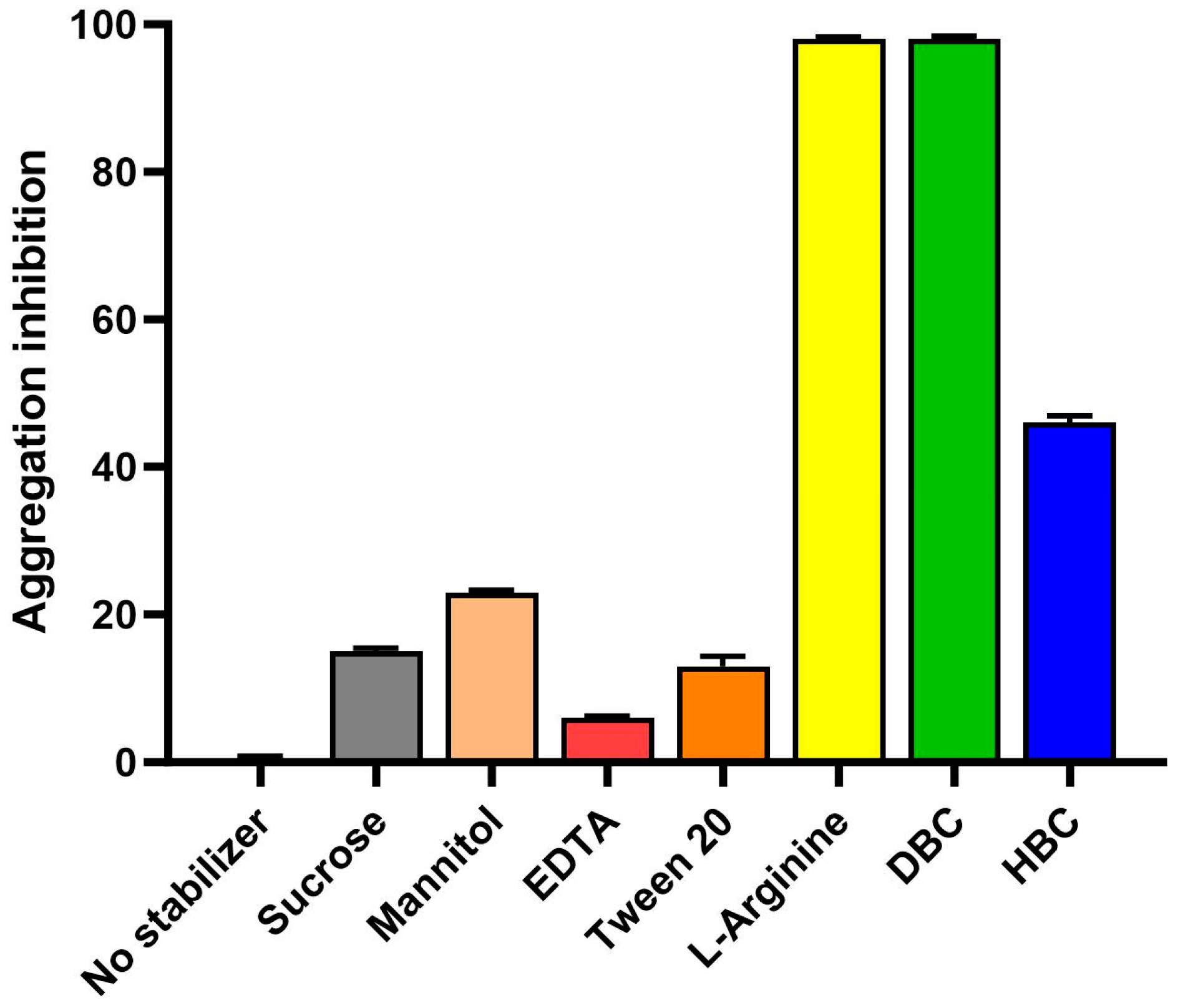
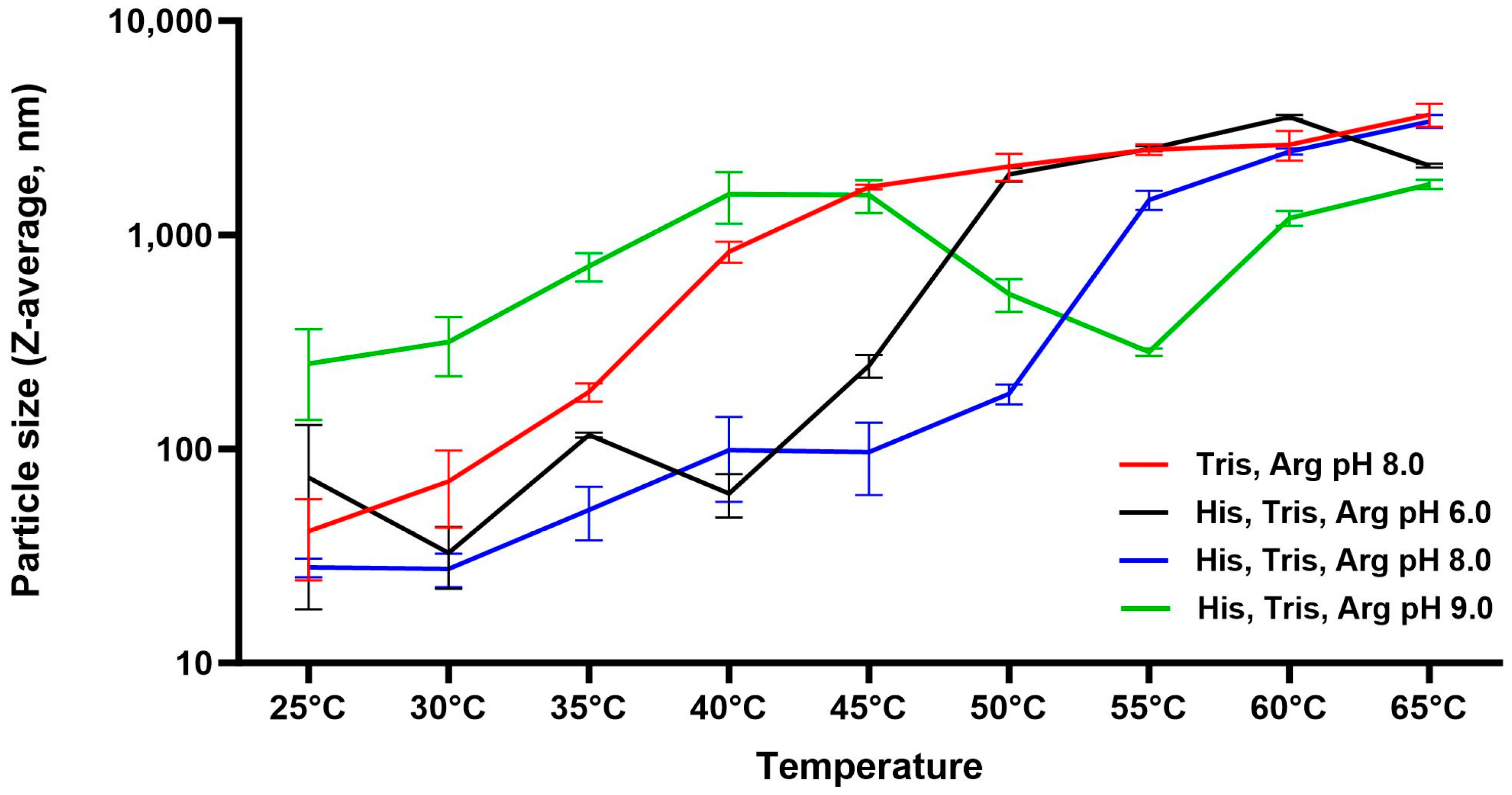
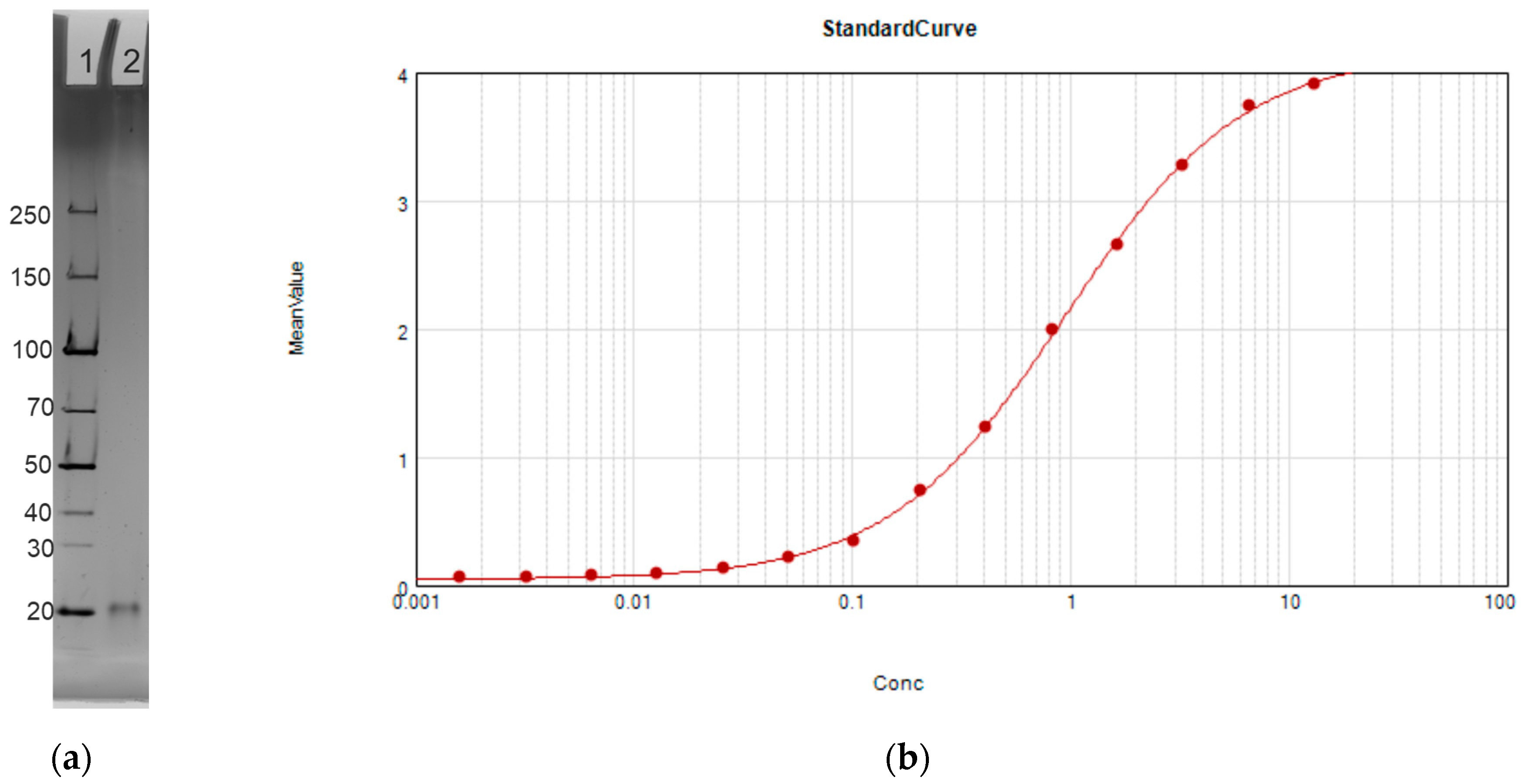



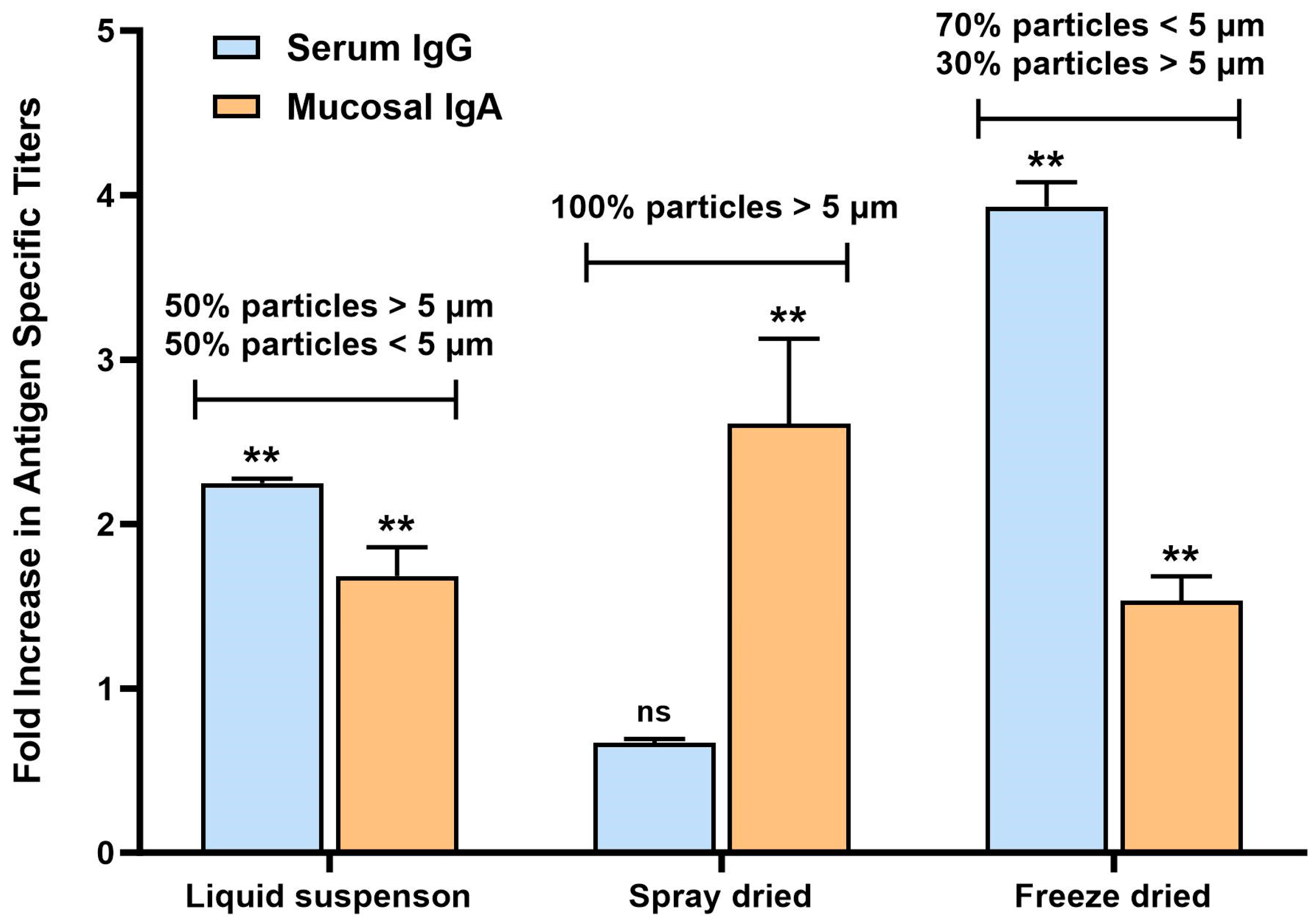

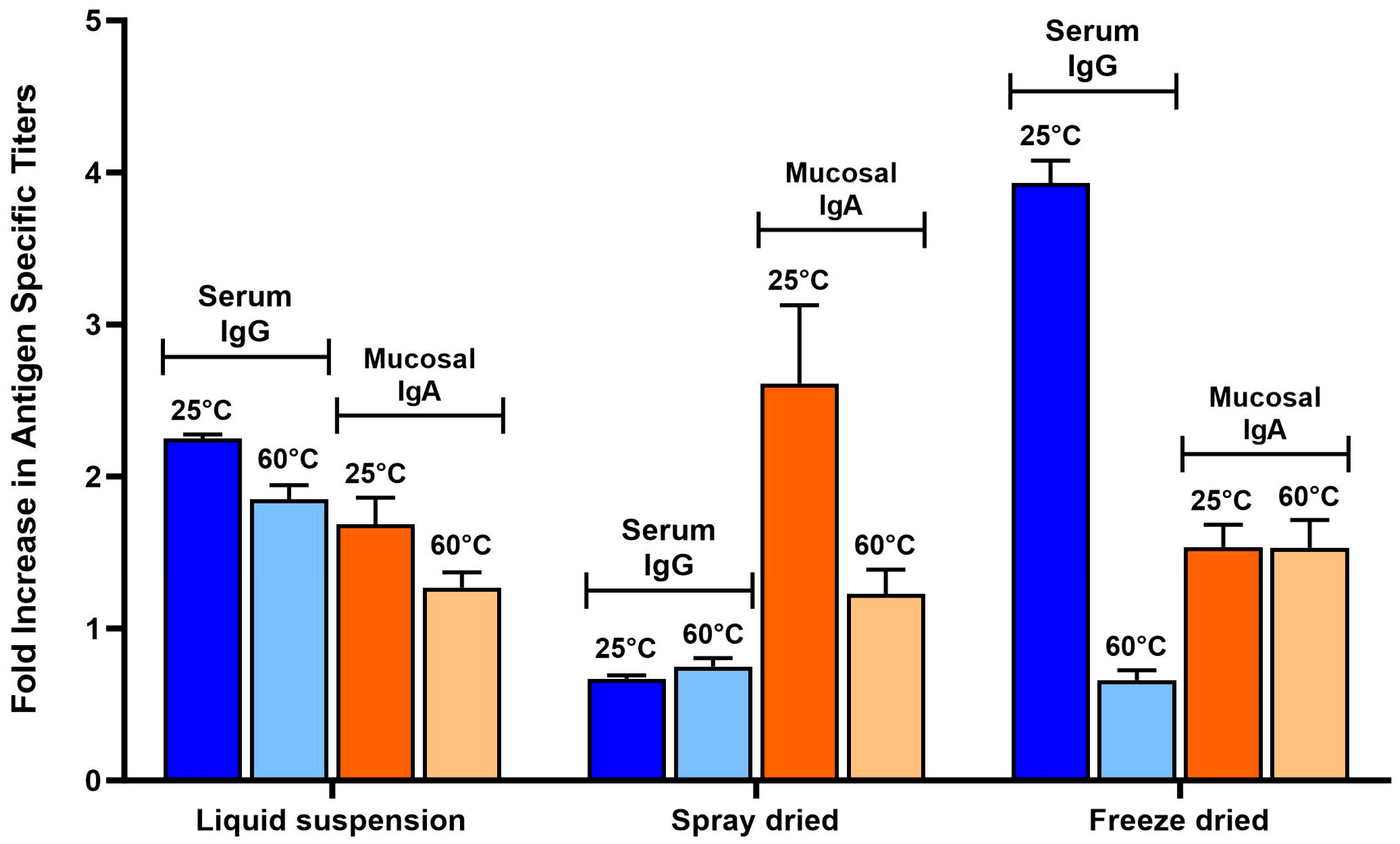
| pH | Z-Average (nm) |
|---|---|
| 6.0 | 73.7 |
| 7.0 | 77.3 |
| 8.0 | 28.0 |
| 9.0 | 250.4 |
| Aluminum Adjuvant | % Protein Adsorbed | % Mannan Adsorbed |
|---|---|---|
| AlOOH high binding | 95.3 | 93.7 |
| AlOOH | 95.7 | 78.7 |
| AlPO4 | 78.7 | 62.2 |
| Zeta Potential (mV) | |
|---|---|
| Vaccine formulation | −4.5 |
| Vaccine in SGF | 6.4 |
| Vaccine in SIF | −29.9 |
| Before Drying (Liquid Suspension) | Spray-Drying | Freeze-Drying | |
|---|---|---|---|
| pH | 4.1 | 4.4 | 4.3 |
| Protein and mannan adsorption | >80% | >80% | >80% |
| Particle size in SIF | 80% of particles between 1 µm and 10 µm | 80% of particles between 1 µm and 10 µm | 80% of particles between 1 µm and 10 µm |
| Reconstitution time | N/A | <3 min | <3 min |
| Vaccine | Reconstitution Time | pH | Adsorbed Protein (µg/mL) | Adsorbed Mannan (µg/mL) | Zeta Potential |
|---|---|---|---|---|---|
| Liquid suspension 25 °C | <1 min | 4.1 | 27.8 | 25.0 | −5.0 mV |
| Liquid suspension 60 °C | <1 min | 4.2 | 39.4 | 23.7 | −9.0 mV |
| Spray-dried 25 °C | <1 min | 4.4 | 32.1 | 18.9 | −6.4 mV |
| Spray-dried 60 °C | <1 min | 4.5 | 51.1 | 25.0 | −2.3 mV |
| Freeze-dried 25 °C | <1 min | 4.3 | 28.1 | 23.0 | −8.9 mV |
| Freeze-dried 60 °C | <1 min | 4.4 | 38.6 | 22.4 | −7.6 mV |
Disclaimer/Publisher’s Note: The statements, opinions and data contained in all publications are solely those of the individual author(s) and contributor(s) and not of MDPI and/or the editor(s). MDPI and/or the editor(s) disclaim responsibility for any injury to people or property resulting from any ideas, methods, instructions or products referred to in the content. |
© 2024 by the authors. Licensee MDPI, Basel, Switzerland. This article is an open access article distributed under the terms and conditions of the Creative Commons Attribution (CC BY) license (https://creativecommons.org/licenses/by/4.0/).
Share and Cite
Burlet, E.; Thomas, N.; Carwell, S.; Gershman, B.W.; Morefield, G.L. Formulation Attributes Impact Immune Profile of an Oral and Thermostable COVID-19 Subunit Vaccine. Vaccines 2024, 12, 1087. https://doi.org/10.3390/vaccines12101087
Burlet E, Thomas N, Carwell S, Gershman BW, Morefield GL. Formulation Attributes Impact Immune Profile of an Oral and Thermostable COVID-19 Subunit Vaccine. Vaccines. 2024; 12(10):1087. https://doi.org/10.3390/vaccines12101087
Chicago/Turabian StyleBurlet, Elodie, Nissy Thomas, Shanna Carwell, Brett W. Gershman, and Garry L. Morefield. 2024. "Formulation Attributes Impact Immune Profile of an Oral and Thermostable COVID-19 Subunit Vaccine" Vaccines 12, no. 10: 1087. https://doi.org/10.3390/vaccines12101087
APA StyleBurlet, E., Thomas, N., Carwell, S., Gershman, B. W., & Morefield, G. L. (2024). Formulation Attributes Impact Immune Profile of an Oral and Thermostable COVID-19 Subunit Vaccine. Vaccines, 12(10), 1087. https://doi.org/10.3390/vaccines12101087






